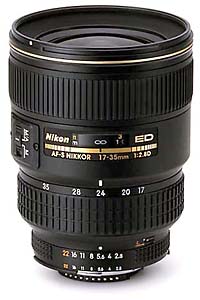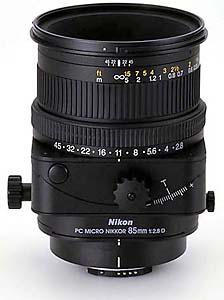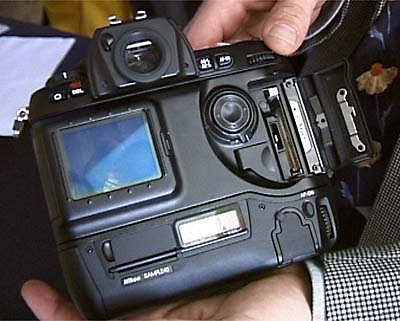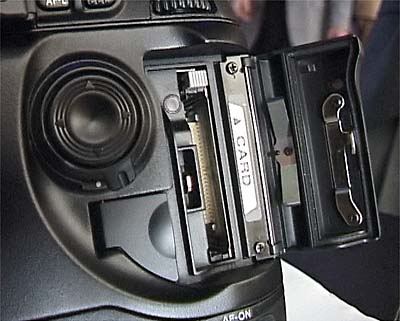The new Nikon Professional Digital SLR
by John Henshall

Nikon D1 professional digital SLR
Nikon, one of the leading Japanese film camera manufacturers, has announced detailed specifications for its forthcoming D1 digital SLR camera, expected to be shown for the first time in a fully-working state with software on Monday August 30 at the Seybold San Francisco digital photography special interest day and to be available by the end of September. The D1's formidable specification and low price are destined to shake up the digital camera market in a big way.
In perspective -- The Kodak connection
The Nikon digital camera project was first mooted at PMA Las Vegas on 18 February 1999 -- the day on which Kodak first showed its DCS620 digital camera, based on Nikon's F5 body and produced, its label says, "In Cooperation with Nikon". Not much cooperation now, it seems: Kodak staff at PMA certainly did not see Nikon's announcement as a friendly act. However, Nikon says that it will continue to honor agreements with Kodak. The Nikon D1 is clearly intended to be a Kodak DCS620 challenger.Kodak have a long and distinguished line of products based on both Nikon and Canon 35mm film camera bodies, stretching back to the DCS100 in 1991. It is fair to say that Kodak have dragged photo-journalism kicking and screaming into the digital age. And they have done it almost single handedly.
The Fuji connection
In 1995 Nikon teamed up with Fuji to produce a joint digital camera, the Fuji DS515 -- also known as the Nikon E2S. Lower-featured models were known as the Fuji DS505 and Nikon E2. This camera produces good pictures but is large, boxy and unwieldy. Relay optics -- used to reduce the 36x24mm images to fit the small CCD -- are the main reason for this bulk. Shrinking the image gives an apparent increase in sensitivity because the smaller image is brighter, though this is offset because the relay optics limit the light passed by all lenses to a widest aperture of f6.7. Worse still, not all Nikon lenses will work with the relay optics.Fuji produced the imaging technology for these cameras; Nikon the body and optics. Not an attractive product, its main gain for Nikon must have been experience.
The Canon connection
Although the first two generations of Kodak digital cameras (DCS100 and DCS200) were exclusively Nikon-body based, an increasing number of photojournalists were using Canon equipment. Consequently, Kodak made a Canon bodied variant of its third generation camera, the DCS420. When Kodak introduced its fourth generation cameras in 1998, the first products -- the DCS520 and its big brother the DCS560 -- were both based on Canon bodies, not Nikon. Canon market the DCS520 themselves as the EOS D2000 but, interestingly, do not market the DCS560. Canon have not done as much as Kodak to promote the EOS D2000 and it will be interesting to see how they react to Nikon's moves.
Going it alone
By 1998, the world of photojournalism was largely digital and yet the only Nikon-based digital cameras were obsolescent products. It took Kodak a further year to introduce the Nikon F5-based version of the DCS520, the DCS620. Nikon must have realised that this would lead to further loss of market share. They could not allow their future to depend on Kodak and had no alternative but to look elsewhere. But to whom?Japanese companies do not like to be subservient partners. Even Nikon's alliance with fellow-Japanese Fuji had not been without its difficulties. One can only guess at the effect a self-assured delegation from corporate Rochester would have had on the Japanese.
At the same time, Nikon were having a good measure of success with their CoolPix 900 camera, launched in March 1998. Although the industrial design looked like a poor Detroit copy of the beautiful Agfa ePhoto1280, the pictures the CP 900 produced were very good indeed. A year later, in March 1999, the new CoolPix 950 made no mistakes. At $999, its picture quality -- though not its functionality and speed -- is uncomfortably close to Kodak's $15,000 DCS620.
Under the leadership of Naoki Tomino, General Manager Kaihatsu (Product development), Nikon have learned very quickly. Strategic alliances are now unnecessary for Nikon. For the new D1, the only tie-up Nikon appear to have is with the CCD manufacturer -- and they are playing that name very close to their chests.
Rear view of the Nikon D1 with CompactFlash card bay open
What we do know about the CCD sensor
The D1 features a 23.7x15.6 mm CCD - a 2.74 megapixel area array CCD with 2,012 x 1,324 active pixels. Image size is 2,000 x 1,312 pixels, captured at a depth of 12 bits per pixel. No relay optics are used to "shrink down" the 36x24mm image produced by the lens to the size of the CCD -- as in Nikon's previous digital SLR collaboration with Fuji -- so there is an apparent lengthening of the focal length (narrowing of angle of view) of lenses by a factor of 1.5x when compared with their use on a 35mm film camera. The picture aspect ratio is 1.5 to 1 - the same as a frame of 35mm film -- and the CCD size is close to the 30.2x16.7mm frame size of APS.

This diagram shows the comparative sizes of the Nikon D1's CCD (pink), a frame of APS film (yellow), and a frame of 35mm film (blue). (On a 72 pixel per inch monitor this will be displayed at actual size.) Note that the Nikon D1 frame area is close to that of APS but less than half the area of a frame of 35mm film.
New lenses


Above left: AF-S 17-35mm f2.8 IF-ED lens. Above right: PC Micro-Nikkor 85mm f2.8 D Lens
To offset the effect of apparent focal length lengthening, Nikon have designed a special 17 - 35mm f2.8 zoom lens which will serve as an excellent 'standard' lens for the D1. This ultra-wide zoom has lens angles approximately equivalent to 25.5 - 52.5mm on a 35 film camera. No price has been given for this lens. Although it's good to have a zoom, it will need a well-designed rectangular lenshood which takes into account the reduced format size.A new PC Micro-Nikkor 85mm f2.8 lens has built-in shift and tilt movements, making the camera suitable for applications such as architectural photography (correcting building verticals) and advertising photography (controlling plane of focus and distortion). The extra image field coverage needed by such lenses is helped by the fact that the CCD is somewhat smaller than a 35mm film frame.
The D1 is compatible with all Nikon F-mount lenses, with differing functionality depending on age and type. This is a huge advantage to professionals who have built up a large stock of specialized lenses.
D1 Features
The new digital Nikon has a strong, lightweight magnesium body. Although not waterproof it claims a "high resistance to penetration by water drops", implying use in the rain if not in the pool.The camera-ready time is less than half a second and the shutter lag (reaction time after pressing the shutter release) is only 58 milliseconds -- similar to that of the F5 with film.. These are key factors in being able to capture the precise moment: many digital cameras have unacceptably long shutter lag times.
|
Shooting modes |
Features |
|
Continuous (C) |
Shooting rate of 4.5 fps for up to 21 shots |
|
Single (S) |
One shot at a time. Capture preview available. |
|
Self-time (Sf) |
Self-timer mode |
|
Play (Pb) |
Play mode and menu setting |
|
PC (Pc) |
Data transfer to computer |
Fastest shooting speed is 4.5 frames per second in bursts of up to 21 shots in a continuous sequence. Sensitivity is equivalent to ISO 200, with "push processing" to ISO 400, 800 and 1,600.
Exposure
modes Program
auto mode with flexible program
possible Shutter
priority auto Aperture
priority auto Manual
mode
The D1 has three exposure metering modes: 3D color Matrix metering, Centre weighted and Spot. Exposure compensation is +/- 5 f-stops in half or one-third steps. An auto exposure bracketing facility enables up to three shots to be separated by 1/3, 1/2, 2/3 or a full f-stop. The facility to create users' own "custom settings" of combinations of functions is one of many features brought over from Nikon's popular F5 and F100 film SLRs. These functions include some which are exclusive to this digital Nikon, such as Tone Compensation and Edge Enhancement. Most Japanese cameras impose a level of edge enhancement as standard: the ability to dispense with this until images are prepared for pre-press will be a big advantage. USM should be applied to an image once only.Images pass through a "lithium niobate" infrared low-pass filter just in front of the CCD. This filter fulfills a dual purpose, protecting the CCD from excessive infra red light and blurring the image very slightly to minimize color aliasing effects.
The Nikon D1 CompactFlash card bay.Captured images are stored on-camera in various TIFF or JPEG forms on Type I or II CompactFlash cards or the new 340Mb IBM MicroDrive.
|
Image quality modes |
|
|
|
Raw (uncompressed 12 bit) (requires optional "Nikon Capture" software to access) |
3.81 MB |
16 per 64MB card |
|
Hi (uncompressed YCbCr-TIFF 8 bit) (requires optional "Nikon ViewDX" software to access) |
5 MB |
12 per 64MB card |
|
Hi (uncompressed RGB-TIFF) |
7.5 MB |
7 per 64MB card |
|
Fine (JPEG approx 4:1) |
1.25 MB |
48 per 64MB card |
|
Normal (JPEG approx 8:1) |
640 KB |
97 per 64MB card |
|
Basic (JPEG approx 16:1) |
320 KB |
195 per 64MB card |
The top shutter speed is 1/16,000 second (one sixteen thousandth of a second -- we state this in words because one of Nikon's leaflets states it incorrectly as "1/1600" second). This very high top speed is made possible by an electronic shutter. The only mechanical shutter is a grey 'curtain' shutter, the primary purpose of which is to reduce smear and to act as a film tone/reflectance simulation for flash measurement in the focal plane. Highest flash synch speed is 1/500 second.
|
White balance modes |
|
|
|
Through the lens using a second 1005 pixel CCD |
|
|
Six settings with seven step fine tuning |
|
|
Factory set levels |
Images, menus and histograms are viewed on-camera using a 120,000 pixel two inch low temperature polysilicon TFT colour LCD screen. NTSC/PAL video output enables images to be soft-proofed on standard television sets. Connexion to the computer is by FireWire (IEEE 1394).
New SB-28DX flash gun
Film cameras calculate the amount of flash required for correct exposure by measuring the flash reflected off the film during exposure. But this technique does not work effectively when measuring flash reflected from a CCD.
Different systems have been devised to try to overcome the problem, with varying degrees of success. One type is E-TTL which calculates exposure from the light at the plane of focus in the viewfinder uses light that is read off the plane of focus in the viewfinder focusing plane. The ill-fated Epix-Pro camera from 1996 used a system of pre-flashing which calculated exposure using the actual CCD. Nikon has developed a technique which reads the exposure from a pre-flash reflected off a grey curtain behind the mirror, just in front of the CCD. Because the curtain clears the imaging plane after the mirror has risen, its calculation is nearer the instant of exposure than when using E-TTL.
Flash technology is one of the Nikon system's real strengths. It includes a selection of fill-flash features, including Nikon's 3D Color Matrix Automatic Balanced Fill-flash. The Fill-flash system will also provide further levels of performance when used with the Center-Weighted and the Spot Meters, and the System is compatible with all exposure control modes, including all automatic and manual modes. Flash bracketing is also possible. The new SB-28DX flash gun will allow photographers to take advantage of all these features.
Pricing issues
If it's unusual to announce so many features of a forthcoming product so far in advance of the launch date, it's even more unusual to announce such an aggressive price point with such confidence at such an early stage of development. Manufacturers of important new products usually hedge when asked about prices of forthcoming products. They prefer to judge reaction and adjust the price accordingly. Then it's a matter of what they hope the market will stand. Nikon have not done this with the D1. But Nikon are very confident.The price of the D1 is expected to be $5,580 - over 60% less than the $15,000 DCS620. In the UK the D1 will be £3,600. Maybe we'll see street prices as low as $4,995 and £2,995?
Our take
When dramatic change occurs, conjecture is understandable. How it is accomplished? At what cost?The most expensive part of a digital camera is usually the CCD, which can cost as much as $2,000 each. So how can Nikon pitch its price so low? Maybe the low price indicates a low-cost CCD? Or is Nikon making the D1 a loss-leader, to buy market share quickly? If so, Nikon's price point must be a big gamble. Kodak has years of experience in this field, while Nikon is virtually launching from a standing start. But Kodak adapts the SLR bodies made by other manufacturers (Canon and Nikon) to make them digital. That's an expensive process. Nikon, with a formidable optical and mechanical reputation, designs and manufactures their own camera and lens line. That's economical. And Nikon don't make any money from selling film, so there are no film losses to balance against the digital gains.
The D1 is already having a profound effect on the market. There may even be casualties. Sales of digital SLRs are in a state of limbo -- or is it a state of shock? -- waiting for the D1 to deliver. Kodak will not take the Nikon D1 lying down. We expect to see some real action from that quarter in the coming months. The competition will be good for everyone.
Why choose the Nikon D1?
The D1 should please photojournalists, other professional photographers and serious amateurs when it delivers in October 1999. It's not just the low price of the Nikon D1 which makes it an important product, though the price will undoubted persuade many more photographers that now is the time to take the plunge.The most important aspect of the D1 is that it promises the largest swathe of professional features seen in any digital camera to date.
Nikon Corporation Japan
Nikon UK Ltd
Nikon Inc USA
Any further news and views? Let us know.
Our digital camera index of past and present products
This
is an extended version of the article which first appeared
as "John Henshall's Chip Shop" in "The Photographer"
magazine, July 1999.
IMPORTANT NOTICE
This document is Copyright © 1999 John Henshall. All
rights
reserved.
This material may only be downloaded for personal
non-commercial use. Please safeguard the future of online
publishing by respecting this copyright and the rights of
all other authors of material on the Internet.
v.990630
![]()
![]()

